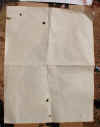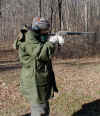The New England Firearms "Tamer" .410
By A. K. Church
Proud member of www.milesfortis.com
Photography by Doc Tom and Miles Fortis, edited by John Dunn
Completed 27 January 2003
(Click on the photos for a larger image.)
(Free permission to quote Church's articles is granted, as long as proper attribution is given. We request that if you use our work, you give us credit.)
Some years ago, I was introduced to the Northwestern American idea of the "Mushroom Gun". These were carried by mushroom pickers and consisted of whatever inexpensive, used single-shot shotgun was available. These were cut back to around legal US minimum (26 inches overall, 18 inch barrel). The butt stock especially is usually minimal in size as these guns were primarily used as 2-handed pistols. Commonly, owing to recoil concerns, these seem to mostly be .410 to 20 gauge.
One American concern had taken up this idea by the early '80s, and introduced the "Snake Charmer", a stainless steel .410, of minimal length, and with the added refinement of the pistol grip containing built-in storage for a few rounds of .410.
I briefly owned one and liked the reliability and corrosion resistance of the little gun. It was sufficiently compact to store unobtrusively aboard the VW Beetle I then drove. I could not, however, get used to the lack of a buttstock, and so the gun the gun moved on for a .22 semiauto rifle.
A few years back, the sporting goods manager in a major American retailer (Wal~Mart) showed me a New England Firearms gun obviously based very much on the concept of the Snake Charmer. Based on the standard action of all NEF shotguns in the range of .410 bore to 12 gauge 3", it carried a short full choked .410 barrel, a rust resistant electroless nickle finish, and polycarbonate stock and forearm. The butt stock on this one was long enough to serve as such, and carried provision for the storeage of 4 rounds of .410 bore shotshell. Nominally rated at a 20" barrel and 6 pounds weight, the gun borrowed for this test has a 19 1/4" barrel, and seems to weigh a good bit less-we'd guess maybe 4 3/4 to 5 pounds..
The shorter barrel provides a fairly neutral balance, the center of mass lying about an inch forward of the trigger guard. While the buttstock is short, I had no difficulty in using it as a conventional butt. The buttplate is rock hard, but the minimal recoil of the .410 makes it comfortable enough to use. No provisions are made for sling attachment, which is an odd oversight.
Even held at the side loosely, the muzzle is well above the ground.
Mechanical details
The action features a mechanically cocked hammer, connecting to a floating firing pin via a transfer bar, and is safe as an operational firearm can hope to be.
The barrel release is next to the hammer, and when pressed down allows the barrel to be pulled down for loading and ejection. True to all NEF rifles and shotguns I've used, this one ejects even loaded rounds with ferocious authority.
The forearm can be detached via one large Phillips screw, and when removed, the barrel can be tipped down and removed from the receiver. This allows compact storage in a space of approximately 19"x7 1/4"x4".
(Take-down case from Galati International.)
The buttstock is attached to the receiver by a throughbolt. It appears the throughbolt on the test gun has a half dozen washers serving as spacers. The ammuntion storage has crudely adjustable tension via 2 Phillips screws applying pressure to rubber retention cylinders, which in turn press against the individual shotshells.
Firing the Tamer
.410s tend to get used in some roles over and over. As a trainer for children, in my opinion, the small shot charge counteracts the light recoil, and perhaps a 28 or 20 gauge would make more sense. Some users enjoy the light weight and easy carrying nature of these petite smoothbores, and the tamer certainly fills this niche. Finally, like the M6 survival gun, the minimum dimensions of both the guns and ammunition suit them to storage and carriage in limited spaces-and even 2 1/2 .410 can be an efficient game killer in the hands of a shooter who's willing to learn its limits.
.410 ammunition generally is one of 3 types.
(1) Generally most useful is the shotshell load, which even in the 3 inch magnum round carries less than 3/4 ounces of shot. So generally ranges are kept close, and in my opinion the concentration of full choke is usually a fine idea. Commonly, 2 1/2 inch carries 1/2 ounce shot, the "magnum" 3" 11/16 ounce.
Shot at 20 yards, these are representative of patterning.
3" 11/16 ounce #4. Pattern density is marginally adequate. It would work, but you'd hope for better.
Not photographed owing to cold induced camera battery failure, 2 1/2" 1/2 ounce #6 shot provided the answer, showing patterns both tighter and better distributed. I don't regard this as a drawback at all. 1/2 ounce loads will kill small game quite well, and the 1/2" of saved space may be a storage plus. This gun is destined to live its days launching a half ounce of #6 or 7 1/2 shot.
(2) Preferred by some for larger animals, especially dangerous animals such as feral pack dogs, multiball loads employ 3-5 subcaliber (.33) lead round balls. At least two brands are available in the US, Winchester, and the Argentine made Rexio. Both are pretty poorly distributed. Searching gun stores throughout a metro area of over 250,000 people, 2 boxes of each were found.
Winchester ammo was used.
This represents accuracy at 25 yards, fired over the bead sight:
Not very impressive, I'd leave this at home myself.
(3) The rifled slug offers a very light (1/5 ounce) projectile moving at a fierce 1850 foot seconds. Impressive at a glance, the severe lack of sectional density and ballistic coefficient means the slug sheds velocity faster than little black dresses at a Christmas party. Stories are told of deer being killed with this load, but presumably mighty close in. This would seem like a better load for anchoring tough smaller game at short range, and southern US hunters describe it as being good for swamp raccoon hunting.
The grouping, pretty close to 2 inches is surprisingly good. The regulation with the sights is way high (6") and way left (3 1/2"). Not sure how useful I'd find it, but at 25 yards it would have it out at the edge of the vital zone on a whitetail. Photos were apparently an emailing incident victim.
OK, in the end I consider this a very light shotgun, whose chosen payload would be the 1/2 ounce short shell. This is acceptable to me.
Ergonomics
The odd looking thumbhole/pistolgrip buttstock is actually pretty comfortable, and allows the storage of 4 rounds of ammunition in a position obviously biased toward the needs of right-handers.
The controls were well located. Loading did require the removal of gloves in +18 degree Fahrenheit weather. Firing and ejection did not, although the trigger finger is a tight fit inside the trigger guard. As stated the gun was easily shouldered, cocked, and fired one handed, and recoil with any of the ammunition used was predictably light. Frankly, it was only a little slower coming on target for me than it was 2 handed.
The factory accessory hammer extension for the Handi-Rifle series would be a significant plus for work with gloves, and this gun is going to get one.
Conclusion
The test gun is very definite in its ammo preferences, and is going to be most happy if fed a diet of the better-patterning 2 1/2 inch .410 shot loads. It is hardly the first .410 to show a patterning preference with the short case.
It is very compact, and shows no signs of being anything other than reliable. For someone seeking a camp gun, one to leave aboard a boat, carry taken down on a snowmachine, or otherwise needing an unobtrusive light shotgun, this would serve well.
EMail Church: akchurch@bigfoot.com. Church welcomes your text messages, but sadly must destroy file attachments without mercy. For further information regarding the .410 shotgun load in it's many venues, visit the .410 Shotgun Resources site courtesy of our friends across the Atlantic.
For information on hand-loading the sturdy .410, have a look here. Remember that hand-loading is at your own risk.
NOTE: Author Church regrets that he is unqualified to do appraisal, and cannot establish a value on your gun.
visitors since website crashed AUG 2003



